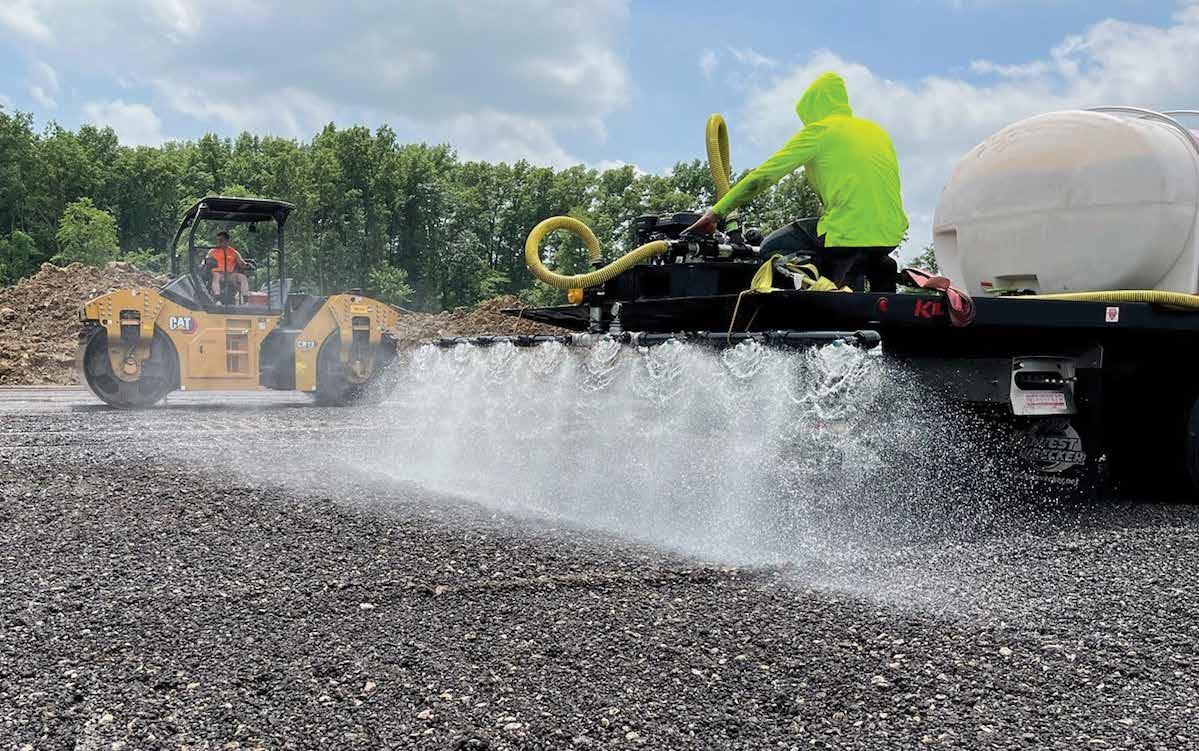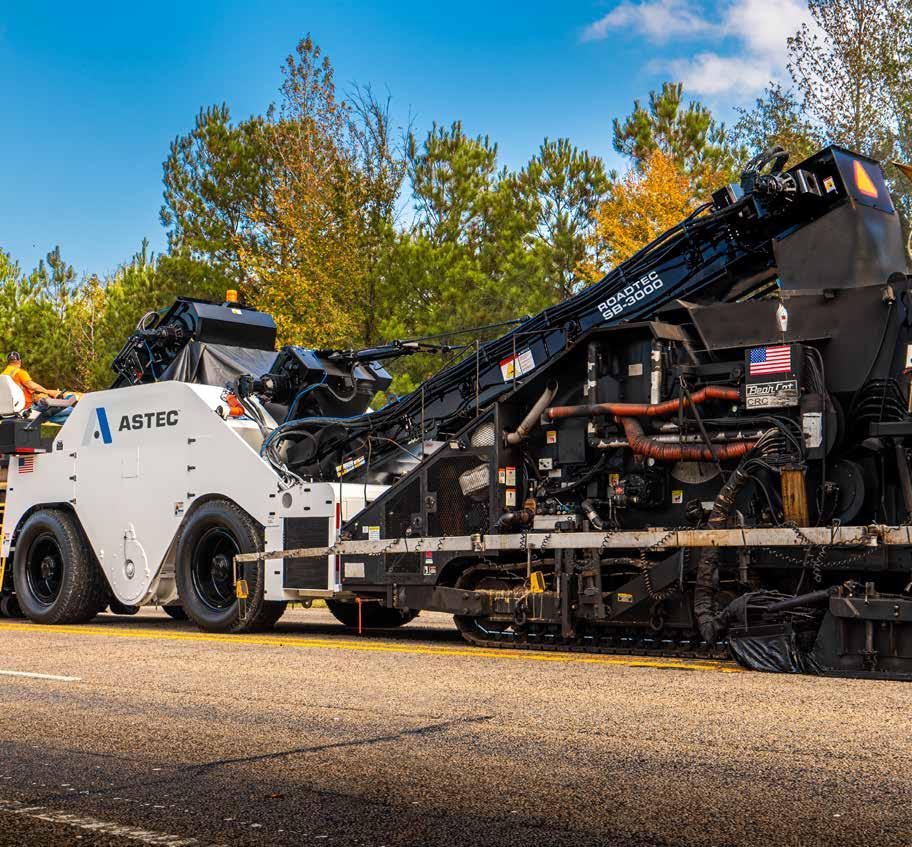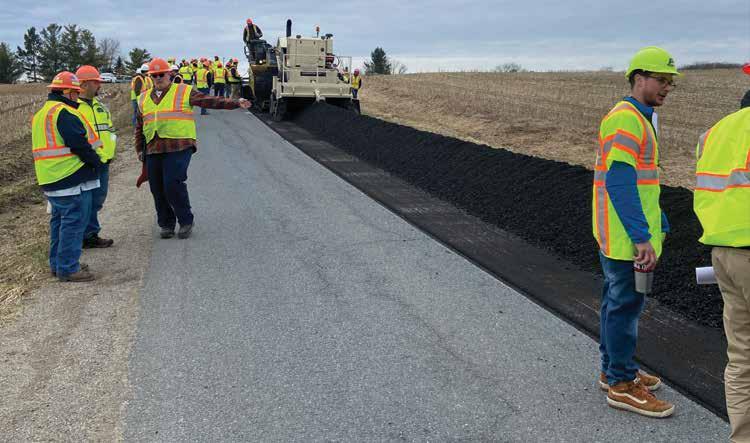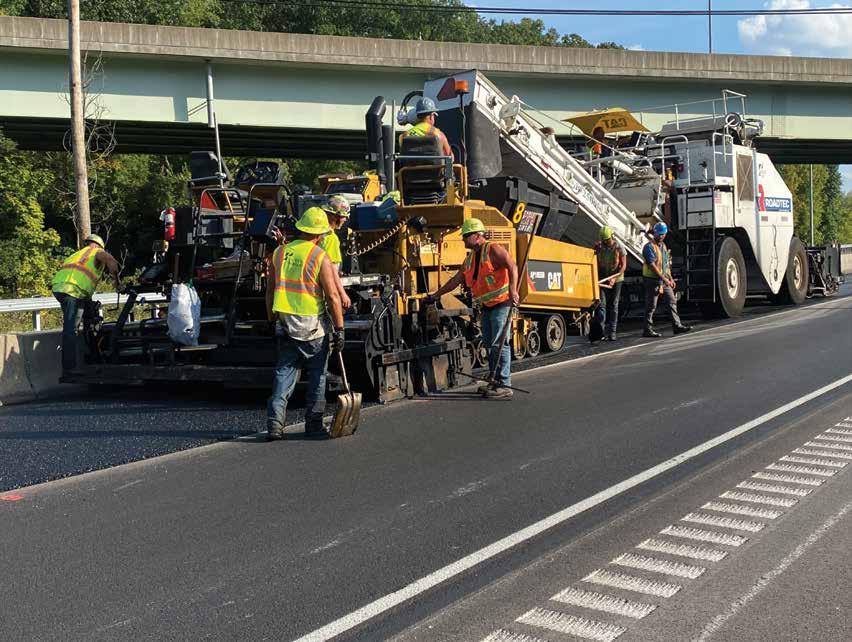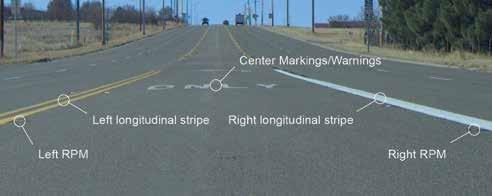
17 minute read
Learn How to Write a Grant
BY SANDY LENDER
It may catch asphalt professionals off guard to find a plant-related product and services gallery introduced by an article about grant-writing. Your average asphalt company owner or CFO may be hesitant to go through the effort of learning how to write a grant, but the skill could take on great importance in the next few months for the for-profit entities in the industrial sector.
Specifically, if your asphalt plant still has room to reduce greenhouse gas (GHG) emissions, you may be eligible to receive a Department of Energy (DOE) rebate of up to 50% of your costs for engineering and installing advanced technologies that assist in decarbonizing industries within the United States. Within the Inflation Reduction Act (IRA), the National Asphalt Pavement Association (NAPA) has identified seven sections where the asphalt industry may take advantage of such grant funding opportunities.
This list is sourced from the NAPA document “Key Asphalt Provisions in the Inflation Reduction Act,” which you can read in its entirety on the NAPA website under the Advocacy link. I’ll list the section that involves our topic of grant-writing last and remind readers, while its program hasn’t gone into effect yet, preparing for it involves steps that will take some time. • Section 60112, Environmental Product Declaration Assistance, under which the Environmental Protection Agency (EPA) has up to $250 million in grants for contractors available until Sept. 30, 2031. • Section 60116, Low-Embodied Carbon Labeling for Construction Materials, under which EPA—in consultation with the
Federal Highway Administration (FHWA) and the General
Service Administration (GSA)—has up to $100 million available to it until Sept. 30, 2026. • Section 60503, Use of Low-Carbon Materials, under which
GSA has up to $2.15 billion available until Sept. 30, 2026. • Section 60504, General Services Administration Emerging
Technologies, under which GSA has up to $975 million available until Sept. 30, 2026. • Section 60506, Low-Carbon Transportation Materials Grants, under which FHWA has $2 billion available until Sept. 30, 2026. • Section 70006, FEMA Build Materials Program, under which the Federal Emergency Management Agency (FEMA) has its existing budget with no new funding. • Section 50161, Advanced Industrial Facilities Deployment Program, under which the Department of Energy’s (DOE) Office of Clean Energy Demonstration (OCED) has up to $5.812 billion available through Sept. 30, 2026.
Looking at the third bullet point above, consider the opportunity to comment on the current availability of your materials that have lower levels of embodied carbon as compared to industry averages, or other estimates of similar materials.
As of Oct. 4, GSA had completed seven paving projects funded by the Bipartisan Infrastructure Law (BIL) using new asphalt standards, according to a GSA press release. The administration is seeking input from industry to learn more about the availability of domestically manufactured, locally sourced, low-carbon construction materials.
The press release stated, “The Buy Clean Task Force is prioritizing low-carbon selections for the most carbon intensive materials (concrete, steel, glass, and asphalt) for construction and building projects, which account for 98% of what the federal government spends on construction materials.” To comment, visit the GSA’s Federal Buy Clean Request page or email embodiedcarbon@gsa.gov by Thursday, Nov. 3.
Obviously, the asphalt industry has been implementing environmentally sustainable practices and upgrading systems with advanced “green” technology over the past few decades. As articles in this publication have pointed out, FHWA and various government entities don’t want to see any sector of industry rest on its laurels, but now are willing to, as NAPA’s current vice president of advocacy Jay Hansen repeatedly tells us, incentivize companies to adopt even more environmentally friendly manufacturing processes. Section 50161 is a prime example of that incentivization, complete with some government bureaucracy to work through. We’ll look at how to make it work over the next few issues of AsphaltPro, and we’ll start with writing grants.
To take advantage of the provisions in Section 50161, you must apply to the DOE for a grant. While the DOE hasn’t put out guidance on the program yet, the equipment manufacturers, additive suppliers and asphalt mix producers need to be ready for when this program takes off in the next few months. The grant money would reimburse the entity up to 50% of the cost to design and/or install advanced technology that is designed to reduce GHG emissions. To apply for a grant, your company must have a unique identifier at SAM.gov and planned unique entity identifier (UEI) at grants.gov. To get the unique identifiers, you must go through an approval process, but the use of these sites is free.
Don’t let this idea of red tape dissuade you from participation. If I may interject a personal anecdote, I’ve participated in non-profit grant-application seminars and in-person round-table discussions to assist sea turtle groups and parrot rescue organizations in finding scraps to keep their doors open. I understand there’s a science to facilitating the application process and an art to writing the grant. It takes a team with different skill sets. It takes time to put it all together. Starting early is one key to success.
Here are some resources for getting that early start rolling: • Your local community college (The director of my local bird sanctuary took a course from Central Florida University alongside an online course from nonprofitready.org. Such local and online resources are easily searchable.) • The home page of Grants.gov (There's a button leading to “Grant
Writing Tips.”) • The EPA’s grant’s page (The slide deck, helpful links, FAQs and recording of the Sept. 13 webinar on Competition Process are available at https://www.epa.gov/grants/competition-process-webinar-september-13-2022.)


Of course, companies aren’t required to apply for reimbursement to implement green technology. As mentioned above, members of the asphalt industry have been upgrading systems and components for decades. But if the government is handing out $5.8 billion for something we already know how to do, why not take the time to jump through the hoops to get some of your monetary investment back as you march ahead on The Road Forward?
In the next few issues of AsphaltPro, we’ll look at how industry might influence what technologies qualify more easily for reimbursement under this grant program, and which might need more explanation in the grant-writing exercise. We’ll also look at which OEMs are on board with assisting you in greening up your facility. Stay tuned.
In the meantime, this month’s product gallery focuses on the plant and production products and services that enhance your bottom line with efficiency and positive sustainability.
ASPHALT SOLUTIONS
Asphalt Solutions Inc., headquartered in Florida, is proud to announce a partnership with AlGol Chemicals in Finland to distribute its time-tested odor suppressant Asphalt Solutions Additive. AlGol Chemicals is leading the way in Europe, developing innovative and high-performance asphalt products for road construction and maintenance. AlGol first used Asphalt Solutions Additive in their facilities in Finland, Denmark, Sweden and Estonia in 2020 with successful results, leading the way to offer other countries the opportunity to solve odor control issues they may be having associated with the asphalt paving and roofing industries. Asphalt Solutions Additive was first patented in 2002 for use in paving asphalt production, followed by the Roof Odor Additive for roofing asphalt applications, which was granted its patent in 2006. Asphalt Solutions looks forward to a successful future with AlGol Chemicals in the markets they serve.
For more information, contact AJ Ronyak at (623) 853-2273.
ASTEC
Astec Industries’ Materials Solutions Group has launched its newest mobile high frequency screening plant, the GT2612V. The plant features a 2612V Vari-Vibe™ high frequency screen. The two-deck, 6-foot by 12-foot screen uses a unique rotary tensioning system. The 2612V also has deck-mounted, variable-speed hydraulic vibrators, a hydraulic mechanism for varying operating angles, a fines collecting hopper, top and bottom deck discharge chutes, and an aggregate spreader. The high frequency screen is designed to size crushed stone, recycled asphalt pavement, sand, gravel, coal and a variety of other materials.
The mobile GT2612V is manufactured on a heavy-duty, welded steel main frame with a channel cross section. A walkway around the screen and remote grease lubrication for ground-level access are designed to make maintenance simple.
The plant includes a large hopper with a capacity of 8 cubic yards that is equipped with 6-inch sloped grizzly openings and a remote tipping grid. The hopper also includes foldable wings and hydraulic support legs. The variable-speed, 48-inch-wide belt feeder features a high-torque hydraulic drive, full length impact bed, rubber lagged head pulley and self-cleaning wing tail pulley. The screen plant is equipped with four conveyors: a delivery conveyor, two side conveyors and a fines conveyor. All conveyors feature a variable-speed hydraulic drive and fold for transport.
The GT2612V is powered by a Caterpillar Tier 4 Final, 136-horsepower (101.4 kW) engine, while engine-mounted hydraulic pumps operate all plant functions. The plant includes a PLC control system with pendant remote controls for the tracks. Additional options for the GT2612V mobile plant include: engine alternatives (Caterpillar Tier 3 and Stage V), 15-foot hopper/feeder in lieu of standard for additional capacity, heavier-duty grizzly section with replaceable grouser bar cartridge, vibrating grid, bridge breaker, vinyl dust cover, standard steel screen cloth, engine enclosure filter kit, engine block heater, immersion heater, wireless track remote, telematics system, auto-grease system and more.
For more information, email socialmarketing@astecindustries.com.
CLARENCE RICHARD
The Clarence Richard Company, Minnetonka, Minnesota, offers the asphalt level tank gauge, which includes fluid level indicator and alarms. The programmable system is designed to decrease labor, downtime, tank coil damage, and material waste by eliminating the need to stick the tank and by transmitting vital tank data, via signal, to a small computer.
The manufacturer shows the asphalt level tank gauge assists in meeting environmental protection agency (EPA) 40 CFR Part 112 rules and regulations, which require tanks have good engineering practices to avoid discharges.
For more information, visit ezfloweighing.com/.
DEERE
John Deere, Moline, Illinois, expands its G-tier wheel loader offerings to the United States with the 644 G-tier wheel loader, continuing the transition to performance tiering. The expansion of this lineup also includes the new 544 G-tier wheel loader now available in Canada.
“Not every customer is looking for the most technology in a machine. By introducing the 544 G-tier in Canada and expanding the availability of the 644 G-tier into the United States, we are providing our customers with options to help meet their diverse needs,” said Luke Gribble, solutions marketing manager, John Deere. “The G-tier models support customers looking for reliability, without the added extras that they would find in a P-tier or X-tier machine, and that fit their investment levels as well. With the G-tier models, customers are getting the versatility and ruggedness in a machine, without any compromises.”

The mobile GT2612V from Astec features a Vari-Vibe™ high frequency screen.

Now available in the United States, the 644 G-tier leverages industry-proven components for customers in the governmental, rental, site development and asphalt industries. The 644 G-tier wheel loaders include a John Deere 6.8L engine and feature John Deere Teammate axles. Customers can customize the machine through a variety of base-level packages, including options related to locking differentials, ride control, seats, radio and rear chassis work-lights.
Making its debut in the Canadian market, the 544 G-tier is designed to provide a more economical solution in the 3-yard loader size class. The 544 G-tier controls were designed with operators of all skillsets and productivity in mind. Promoting ease of operation, the in-cab controls include adjustable boom-height kickout, return to carry, and return to dig, which can be activated from inside the cab.
All G-tier machines are backed by JDLink™ Connectivity and Connected Support. Both the 544 G-tier and the 644 G-tier machines are eligible for the John Deere Protect™ Service Plan. With the John Deere Protect™ Service Plan, routine maintenance is performed at every 500-hour interval by an experienced John Deere dealer. In addition, the John Deere Protect™ Parts & Fluids Plan provides customers with options to conduct maintenance services and inspection while utilizing their own technicians.
EAGLE
Eagle Crusher Co. Inc., Galion, Ohio, announced in August that Mike Tinkey has been promoted to president of the company. Tinkey previously served as CFO since joining Eagle Crusher in 2002. Susanne Cobey, who previously served as president, will remain as CEO of the company. Previously Tinkey served as CEO, Holbrook & Manter Inc.; CFO, Ohio Industries Inc.; and accounting and audit manager, Ciuni & Panichi Inc.
In naming Tinkey president, Cobey stated, “I have been with Eagle Crusher Co. for nearly 48 years, 32 as president and CEO. I have worked closely with Mike for the past 20 years. As someone who shares a similar company vision, truly understands the industry, and exemplifies a leadership style that recognizes the value of the entire Eagle Crusher team of employees to accomplish goals, I can think of no better person to see Eagle Crusher through its continual growth and take the company to the next level. Already handling many of the responsibilities that the role of president entails, Mike is well positioned for his new role.”
Tinkey said he initially joined Eagle Crusher because of the unique business model Cobey created, capitalizing on the ever-changing crushing industry while always keeping the needs of customers paramount. Of his new position, Tinkey stated, “It is a privilege to be a part of a company that delivers the highest quality crushing and screening equipment, innovative solutions, and phenomenal service and support to all our customers. We have an exceptionally talented team at Eagle Crusher, focused on the continued expansion of our product line to provide the best customer solutions in the industry. I look forward to working closely with Susanne and our entire team to usher in Eagle Crusher’s next chapter of growth and success.”
For more information, visit https://eaglecrusher.com/
HONEYWELL
Producers interested in their upstream scope 3 emissions will also be interested in the latest from Honeywell, headquartered in Houston. The company has unveiled the ECOMAX® LE burner with a metallic recuperator for indirect radiant tube heating applications such as tempering, hardening, continuous lines and annealing. Developed for furnace original equipment manufacturers (OEMs) that need to meet tightening global nitrogen oxide emissions requirements and end users who want to increase fuel gas savings, Honeywell’s latest ECOMAX family member features low emissions, process efficiency and low operating costs.
ECOMAX LE offers both flame and flameless operation, with a switching temperature of 850°C (1560°F). The burner operates in flame mode until the switching temperature is reached, then switches to flameless mode for the best nitrogen oxide performance, delivering an average of 30% fuel gas savings compared to a typical cold air burner and enabling compliance with the latest emissions regulations. In addition, ECOMAX LE burners can run on up to 100% hydrogen without a significant increase in nitrogen oxide emissions, when compared to firing natural gas.
For more information, visit the Honeywell website.
METSO
Metso Outotec Corporation announced at the end of August it has consolidated its minerals testing services in the United States into a single 5,500-square-meter facility located in York, Pennsylvania. The test center capabilities will be continuously developed with the goal of covering the full minerals value chain to support the mining industry worldwide.
“The volume of testing activity has increased significantly during the last year,” explained Alan Boylston, director of process engineering at Metso Outotec. “With more space and operations in one place, we can do a lot more linked and pilot-scale testing. The test center in York specializes in standard and proprietary grinding tests in both laboratory and pilot scale, focusing also on grinding R&D in close co-operation with our office in York. The addition of pyro testing capabilities allows us to run calcining, induration and drying tests, too. Currently, we are also building new capabilities for bench and laboratory scale thickening and filtration tests.”
The Metso Outotec global network of minerals test facilities includes main test centers in the United States, Brazil, Chile, Peru, Finland and Australia.
POWERSCREEN
Powerscreen®, a Terex Brand, has attended the rescheduled Bauma 2022 in Munich alongside its German distributors Kölsch and Christophel. The machine line-up at Booth FN. 1024/1 included the Powerscreen Premiertrak 330 Jaw Crusher and the Chieftain 1700X 3 Deck Incline Screen. The Premiertrak 330 has a two-piece grizzly feeder that sends material flow toward the chamber. User benefits include track mobility for a quick set-up time, and variable crusher speed, according to the manufacturer. The Powerscreen® Chieftain 1700X is a mid-sized tracked mobile screen to allow high volumes of finished products. User benefits include a quick set-up time, drop down tail conveyor ad the patented four-bearing screenbox with the ability to switch to a two-bearing setup in less than three hours, according to the manufacturer.
For more information, visit the Powerscreen website.
Mike Tinkey, president of Eagle Crusher.
From innovative designs to Caterpillar dealer service and support, Weiler is paving the way to success for contractors across North America. Weiler’s material transfer vehicles, commercial pavers, road wideners, windrow elevators, static compactors, soil stabilizers, rock drills, tack distributors and front mount screeds are engineered with innovative features to increase productivity while reducing operating costs. Weiler equipment is sold and serviced exclusively at Caterpillar dealers throughout North America.

weilerproducts.com



PUGMILL SYSTEMS
We’ve been designing and manufacturing custom mixing solutions in Tennessee for nearly 40 years.
RCC • CTB • Pugmix • Stabilized Sand


Coldmix • Fly Ash • Salt Treatment

Rental Plants Available
Check out additional projects at: PUGMILLSYSTEMS.COM or give us a call at: 931-388-0626

The Precision Pin Pusher from Stansteel-Hotmix Parts & Service is designed to press chain’s pins out with ease.
STANSTEEL
The Precision Pin PusherTM is available from Stansteel-Hotmix Parts & Service®, Lexington, Kentucky. The Precision Pin Pusher pushes pins out on 4-inch and 6-inch pitch chains, which means users will only need this one tool for multiple chain sizes. Additional features and benefits include: • This one tool fits most chain sizes. • It has a pushing power of 30 tons. • No more hammers or torches. • Includes a Hard case for storage and security.
For more information, visit https://hotmixparts.com/pinpusher.
YOKOHAMA
The new Galaxy AT Grip Steel steel-belted skid steer radial tire is available from Yokohama Off-Highway Tires, Wakefield, Massachusetts, for skid steers.
Dhananjay Bisht, product manager—Earthmoving, Construction and Industrial Tires for Yokohama Off-Highway Tires America Inc., said the feature customers were most interested in was “a strong sidewall. The feature they admired most about their old bias-ply tires was the stability and durability of the sidewalls. So, we developed a radial tire that delivers the footprint and ride benefits of radial construction as well as a much sturdier, reinforced sidewall.”
The Galaxy AT Grip Steel also features a non-directional block tread design. The blocks are optimized for wear and traction, Bisht noted.
The Galaxy AT Grip Steel steel-belted radial is available in 260/70R16.5, 300/70R16.5 and 360/70R17.5 sizes.
For more information, call (800) 343-3276.
CRUSH RAP COSTS
with the HONEY BADGER
From replaceable abrasion-resistant steel wear liners to a 1/2" steel pulverizing hopper, this machine is ready for wear and tear. And by reducing material handling and minimizing moisture, the Honey Badger increases production and saves on fuel costs. Average return on investment is 1/8 the cost of other crushing operations. Fully-equipped with max power, reliable operation, and easy maintenance, the Honey Badger is ready to crush your costs!

Reduced RAP moisture = lower fuel consumptions

Reduce or eliminate crushing costs
Typical 6 month ROI
(300,000 ton/season plant)
Minimize material handling
STATIONARY PORTABLE




